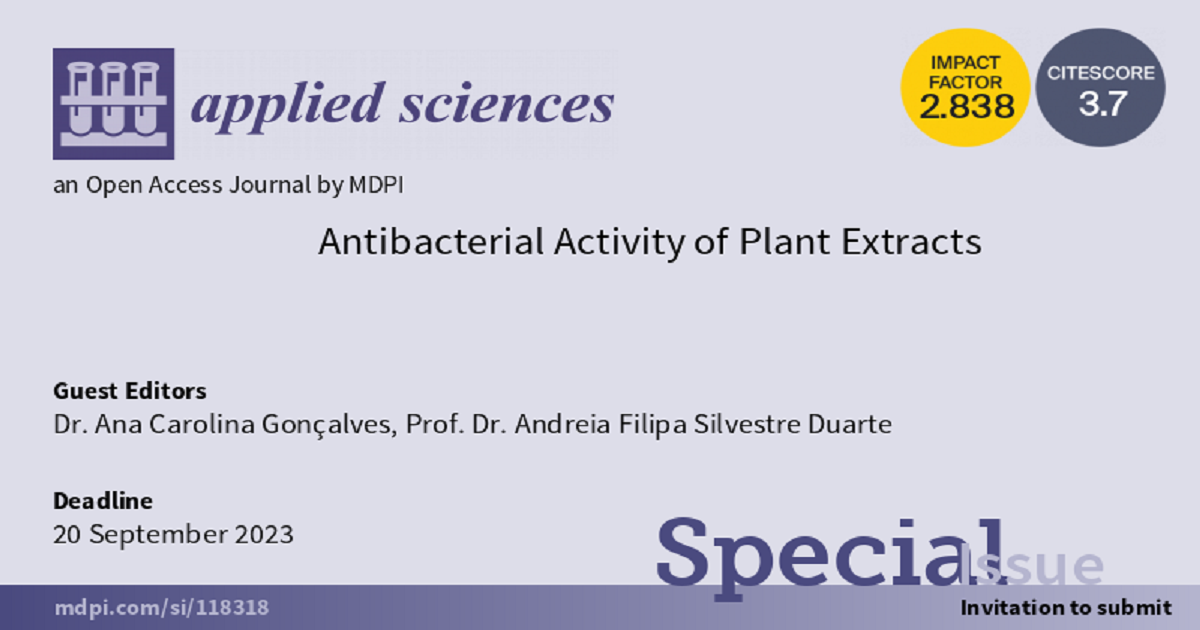Antibacterial Activity of Plant Extracts
A special issue of Applied Sciences (ISSN 2076-3417). This special issue belongs to the section "Chemical and Molecular Sciences".
Deadline for manuscript submissions: closed (20 September 2023) | Viewed by 33128

Special Issue Editors
Interests: pharmacognosy; natural products; phytochemical analysis; high-performance liquid chromatography; phytochemistry; herbal medicine; traditional medicine; biological activities; nutraceuticals; plant extracts; antimicrobials; antioxidants; natural product research; phytomedicine; phytopharmacology; antibacterials; antifungals; antiparasitics
Special Issues, Collections and Topics in MDPI journals
Interests: essential oils; antioxidants; antimicrobials; anti-quorum sensing; natural products; plants; antibiotics; synergism; anti-biofilm; antibiotic susceptibility; genetic diversity; adhesion; biofilm; quorum sensing; bactericidal activity, anti-biofilm activity; antimicrobial properties; antibiotic resistance; antifungals
Special Issue Information
Dear Colleagues,
Over recent years, the efficacy of antibiotics has decreased, mainly due to the emergence of drug-resistant micro-organisms. Therefore, several efforts have been made to search for new alternatives that are able to diminish infectious ailments. Supported by scientific studies, medicinal plants have been a target of intensive research, given their richness in several phytochemicals (e.g., phenolics, volatile organic compounds) which can work as synergic and offer many benefits, including improving the efficacy of conventional pharmaceuticals, decreasing their side effects, and counteracting multidrug resistance. Additionally, they can also be used as a model for developing new drug scaffolds.
This Special Issue will publish high-quality, original research and review papers, in the overlapping fields of:
- Antibacterial properties of characterized plant extracts (e.g., essential oils, infusions, hydroethanolic extracts, …) against determined human diseases;
- Biological potential of phytochemicals extracted from plant extracts, alone or combined with other active ingredients and/or antibiotics;
- Strategies and new technologies to enhance the antibacterial potential of plant extracts, e.g., their (nano)encapsulation with liposomes;
- The structure–activity relationship between the antibacterial activity and phytochemicals content;
- Health-promoting properties and practical use of antibacterial phytochemicals.
Dr. Ana Carolina Gonçalves
Prof. Dr. Andreia Filipa Silvestre Duarte
Guest Editors
Manuscript Submission Information
Manuscripts should be submitted online at www.mdpi.com by registering and logging in to this website. Once you are registered, click here to go to the submission form. Manuscripts can be submitted until the deadline. All submissions that pass pre-check are peer-reviewed. Accepted papers will be published continuously in the journal (as soon as accepted) and will be listed together on the special issue website. Research articles, review articles as well as short communications are invited. For planned papers, a title and short abstract (about 100 words) can be sent to the Editorial Office for announcement on this website.
Submitted manuscripts should not have been published previously, nor be under consideration for publication elsewhere (except conference proceedings papers). All manuscripts are thoroughly refereed through a single-blind peer-review process. A guide for authors and other relevant information for submission of manuscripts is available on the Instructions for Authors page. Applied Sciences is an international peer-reviewed open access semimonthly journal published by MDPI.
Please visit the Instructions for Authors page before submitting a manuscript. The Article Processing Charge (APC) for publication in this open access journal is 2400 CHF (Swiss Francs). Submitted papers should be well formatted and use good English. Authors may use MDPI's English editing service prior to publication or during author revisions.
Keywords
- antibacterial activity
- minimum inhibitory concentration
- plant extracts
- phytocompounds
- pathogens inhibition
- natural compounds
Benefits of Publishing in a Special Issue
- Ease of navigation: Grouping papers by topic helps scholars navigate broad scope journals more efficiently.
- Greater discoverability: Special Issues support the reach and impact of scientific research. Articles in Special Issues are more discoverable and cited more frequently.
- Expansion of research network: Special Issues facilitate connections among authors, fostering scientific collaborations.
- External promotion: Articles in Special Issues are often promoted through the journal's social media, increasing their visibility.
- e-Book format: Special Issues with more than 10 articles can be published as dedicated e-books, ensuring wide and rapid dissemination.
Further information on MDPI's Special Issue polices can be found here.





